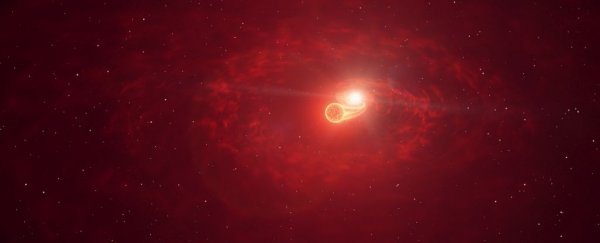
A Rare, Repeatedly Exploding Star Has Been Caught Producing Powerful Gamma Rays
MICHELLE STARR 10 MARCH 2022A rare star that repeatedly explodes appears to be also generating the most energetic form of light in the Universe.
Analysis of an eruption from the binary system RS Ophiuchi has revealed that the shock wave expanding out into space acts as a particle accelerator that generates gamma radiation. This suggests the conditions that generate this radiation need not be as extreme as previously thought.
In turn, it could be that bigger explosions, such as supernovae, are even more powerful particle accelerators, producing cosmic rays with energies greater than a quadrillion electronvolts.
"The observation that the theoretical limit for particle acceleration can actually be reached in genuine cosmic shock waves has enormous implications for astrophysics," explained astrophysicist Ruslan Konno of the German Electron Synchrotron (DESY) in Germany and the HESS Collaboration.
"It suggests that the acceleration process could be just as efficient in their much more extreme relatives, supernovae."
The star in question is a very special kind of binary star. Its name is RS Ophiuchi, located 4,566 light-years away, and it's a type of star known as a recurrent nova, one of only about 10 known in the Milky Way galaxy. As you might be able to guess from the category name, the object periodically erupts in an explosion called a nova, which goes off every 15 years or so.
What causes these eruptions is stellar vampirism (yep, you read that correctly).
The binary system consists of a white dwarf in close orbit with a red giant. As the two whirl around each other, material – primarily hydrogen – is siphoned off the red giant by the smaller, denser white dwarf.
This hydrogen accumulates on the white dwarf's surface, where it heats up. Periodically, the mass becomes so great that the pressure and temperature at the bottom of the layer is sufficient to trigger a thermonuclear explosion – a nova – violently expelling excess material into space.
The most recent nova was observed in August last year, so energetic that RS Ophiuchi temporarily became bright enough to see with the naked eye.
"The stars forming the system are at approximately the same distance from each other as Earth and the Sun," said astrophysicist Alison Mitchell of Friedrich-Alexander University Erlangen-Nürnberg in Germany and principal investigator of the HESS Nova program.
"When the nova exploded in August 2021, the HESS telescopes allowed us to observe a galactic explosion in very-high-energy gamma rays for the first time."
The HESS array consists of five telescopes in Namibia, and was recently upgraded with a new, highly sensitive camera; the array detects Cherenkov radiation when a high-energy gamma ray strikes Earth's atmosphere. This radiation is the 'boom' of light emitted when a gamma ray briefly travels faster than the phase velocity of light in the atmospheric medium (think of it as the light equivalent of a sonic boom).
Scientists can analyze this radiation to determine the energy of the gamma ray that produced it. In the case of gamma rays from the eruption of RS Ophiuchi, these rays were in excess of 100 gigaelectronvolts, or 100 billion electronvolts.
While that's far from the most energetic gamma rays ever detected, what's special here is that the observations have revealed the mechanism that produces them in a nova.
Observing the nova evolve in real time, the team reconstructed the phenomenon that produced the gamma rays. According to their analysis, the shockwave from the white dwarf's nova slams into the red giant's wind, accelerating protons to very high energies, which can collide with each other to produce gamma ray photons.
"This is the first time we have ever been able to carry out observations like this, and it will allow us to gain even more accurate future insights into how cosmic explosions work," says theoretical astrophysicist Dmitry Khangulyan of Rikkyo University in Tokyo, Japan.
"We may, for example, discover that novae contribute to the ever-present sea of cosmic rays and therefore have a considerable effect on the dynamics of their immediate surroundings."
The next-generation Cherenkov Telescope Array, 10 times more sensitive than current ground-based Cherenkov telescopes, should help scientists determine how common this process is in novas.
The research has been published in Science.


comment 0 Comments
more_vert